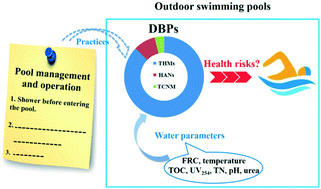当前位置:
X-MOL 学术
›
Environ. Sci.: Water Res. Technol.
›
论文详情
Our official English website, www.x-mol.net, welcomes your feedback! (Note: you will need to create a separate account there.)
Occurrence and factors affecting the formation of trihalomethanes, haloacetonitriles and halonitromethanes in outdoor swimming pools treated with trichloroisocyanuric acid†
Environmental Science: Water Research & Technology ( IF 5 ) Pub Date : 2017-11-06 00:00:00 , DOI: 10.1039/c7ew00245a Fang Yang 1, 2, 3, 4, 5 , Zhaoguang Yang 1, 2, 3, 4, 5 , Haipu Li 1, 2, 3, 4, 5 , Fangfang Jia 1, 2, 3, 4, 5 , Ying Yang 1, 2, 3, 4, 5
Environmental Science: Water Research & Technology ( IF 5 ) Pub Date : 2017-11-06 00:00:00 , DOI: 10.1039/c7ew00245a Fang Yang 1, 2, 3, 4, 5 , Zhaoguang Yang 1, 2, 3, 4, 5 , Haipu Li 1, 2, 3, 4, 5 , Fangfang Jia 1, 2, 3, 4, 5 , Ying Yang 1, 2, 3, 4, 5
Affiliation

|
Swimming pool disinfection by-products (DBPs) have aroused widespread concern in many countries due to their adverse human health effects. In this study, the concentration levels of several kinds of DBPs including trihalomethanes, haloacetonitriles and trichloronitromethane were determined in 35 outdoor swimming pools in Hunan, China. The main water parameters investigated in this study included free residual chlorine, total organic carbon, pH, urea, UV254, total nitrogen and temperature. The management and operation of pools were comprehensively investigated as well. The results showed that the mean concentrations of trihalomethanes, haloacetonitriles and trichloronitromethane in the swimming pools were 21 ± 14 μg L−1, 2.1 ± 1.4 μg L−1 and 0.91 ± 0.51 μg L−1, respectively. Chloroform was the most predominant DBP species detected, and dichloroacetonitrile was the most predominant nitrogenous DBP (N-DBP) species detected. Free residual chlorine and pH might be critical factors in controlling the occurrence of DBPs. Showering before entering the pool could reduce the organic matter from swimmers, and this practice seemed to be an effective way to reduce the formation of DBPs. It is worth noting that urea, as one of the most predominant organic nitrogen compounds in human sweat and urine, had a high concentration in the investigated swimming pool samples. The cancer risks of DBPs in these outdoor swimming pools were lower than the US EPA guidelines in general, while the harm of DBPs couldn't be overlooked at high concentrations.
中文翻译:

三氯异氰尿酸处理过的室外游泳池中三卤甲烷,卤代乙腈和卤代硝基甲烷的形成及其影响因素†
游泳池消毒副产物(DBPs)由于其对人体健康的不利影响而引起了许多国家的广泛关注。在这项研究中,测定了湖南省35个室外游泳池中包括三卤甲烷,卤代乙腈和三氯硝基甲烷在内的几种DBP的浓度水平。在这项研究中调查的主要水参数包括游离残留氯,总有机碳,pH,尿素,UV 254,总氮和温度。还对泳池的管理和运营进行了全面调查。结果表明,三卤甲烷的,卤代乙腈和trichloronitromethane在泳池的平均浓度分别为21±14微克大号-1,2.1±1.4微克大号-1和0.91±0.51微克大号-1。三氯甲烷是检测到的最主要的DBP种类,而二氯乙腈是检测到的最主要的含氮DBP(N-DBP)种类。游离的残留氯和pH可能是控制DBP发生的关键因素。进入游泳池之前进行淋浴可以减少游泳者的有机物,这种做法似乎是减少DBP形成的有效方法。值得注意的是,尿素是人类汗液和尿液中最主要的有机氮化合物之一,在所研究的游泳池样本中含量很高。这些室外游泳池中DBP的致癌风险总体上低于美国EPA准则,而高浓度时DBP的危害不可忽视。
更新日期:2017-11-06
中文翻译:

三氯异氰尿酸处理过的室外游泳池中三卤甲烷,卤代乙腈和卤代硝基甲烷的形成及其影响因素†
游泳池消毒副产物(DBPs)由于其对人体健康的不利影响而引起了许多国家的广泛关注。在这项研究中,测定了湖南省35个室外游泳池中包括三卤甲烷,卤代乙腈和三氯硝基甲烷在内的几种DBP的浓度水平。在这项研究中调查的主要水参数包括游离残留氯,总有机碳,pH,尿素,UV 254,总氮和温度。还对泳池的管理和运营进行了全面调查。结果表明,三卤甲烷的,卤代乙腈和trichloronitromethane在泳池的平均浓度分别为21±14微克大号-1,2.1±1.4微克大号-1和0.91±0.51微克大号-1。三氯甲烷是检测到的最主要的DBP种类,而二氯乙腈是检测到的最主要的含氮DBP(N-DBP)种类。游离的残留氯和pH可能是控制DBP发生的关键因素。进入游泳池之前进行淋浴可以减少游泳者的有机物,这种做法似乎是减少DBP形成的有效方法。值得注意的是,尿素是人类汗液和尿液中最主要的有机氮化合物之一,在所研究的游泳池样本中含量很高。这些室外游泳池中DBP的致癌风险总体上低于美国EPA准则,而高浓度时DBP的危害不可忽视。


























 京公网安备 11010802027423号
京公网安备 11010802027423号